What is the calorie content of carrots in Korean and is it possible to eat it when losing weight
Carrots are a valuable root vegetable with a rich chemical composition and excellent taste. In its raw form, it has a low glycemic index and low calorie content, but it contains a large amount of sugar, which is why it was previously included in the list of foods prohibited on the diet. Modern nutritionists have a different opinion about carrots. The product is recommended to be consumed regularly, without fear of extra pounds. Carrots are included in diet salads and a popular oriental snack.
In this article, we will tell you how many calories are in a Korean carrot, what set of vitamins and minerals it contains, how to reduce the calorie content of a snack and what to cook from it.
The content of the article
Chemical composition, vitamins and minerals of carrots in Korean
The main component of the popular hot and spicy snack is carrots. The root vegetable is rich in vitamins, micro- and macroelements, amino acids (alanine, aspartic, glutamic acids, glycine, tyrosine), saturated and polyunsaturated fatty acids (Omega-3, Omega-6).
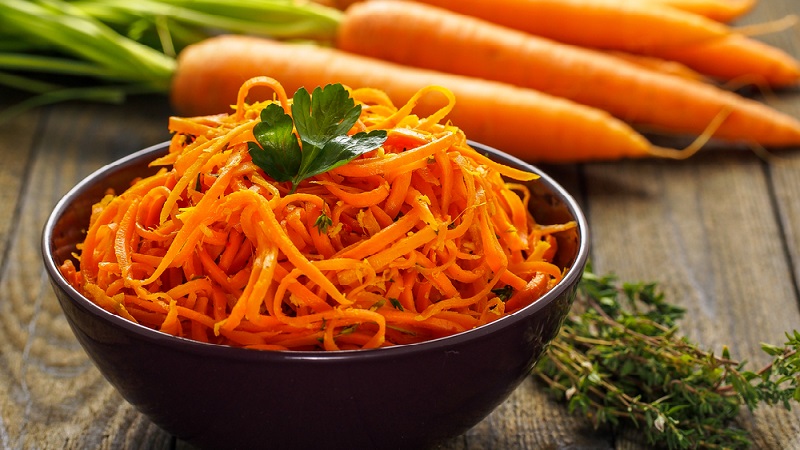
The table shows the chemical composition of the product per 100 g.
| Name | Content | Norm |
| Vitamin A | 6900 mcg | 900 mcg |
| Retinol | 6.9 mg | — |
| Vitamin B1 | 0.05 mg | 1.5 mg |
| Vitamin B2 | 0.06 mg | 1.8 mg |
| Vitamin B5 | 0.2 mg | 5 mg |
| Vitamin B6 | 0.1 mg | 2 mg |
| Vitamin B9 | 6.9 mcg | 400 mcg |
| Vitamin C | 4.2 mg | 90 mg |
| Vitamin E | 3.9 mg | 15 mg |
| Vitamin H | 0.05 μg | 50 mcg |
| Vitamin PP | 0.9992 mg | 20 mg |
| Potassium | 163.7 mg | 2500 mg |
| Calcium | 38 mg | 1000 mg |
| Magnesium | 30.3 mg | 400 mg |
| Sodium | 27.3 mg | 1300 mg |
| Sulfur | 9.8 mg | 1000 mg |
| Phosphorus | 45.9 mg | 800 mg |
| Chlorine | 1764.6 mg | 2300 mg |
| Aluminum | 247.5 μg | — |
| Boron | 153.3 μg | — |
| Vanadium | 75.9 μg | — |
| Iron | 0.7 mg | 18 mg |
| Iodine | 4.2 μg | 150 mcg |
| Cobalt | 2.3 μg | 10 mcg |
| Lithium | 4.6 μg | — |
| Manganese | 0.1907 mg | 2 mg |
| Copper | 73.9 mcg | 1000 mcg |
| Molybdenum | 18.5 mcg | 70 mcg |
| Nickel | 4.6 μg | — |
| Fluorine | 42.1 μg | 4000 mcg |
| Chromium | 2.3 μg | 50 mcg |
| Zinc | 0.362 mg | 12 m |
Reference. The homeland of carrots is the territory of modern Afghanistan. It used to be bright purple, yellow, or white. Dutch breeders gave us the usual orange carrot.
Calorie content, BJU and glycemic index
Nutritional value of the product per 100 g:
- calorie content - 112.6 kcal;
- proteins - 1.2 g;
- fats - 8.2 g;
- carbohydrates - 9 g;
- organic acids - 111.5 g;
- fiber - 4.8 g;
- water - 75.3 g;
- ash - 1.1 g
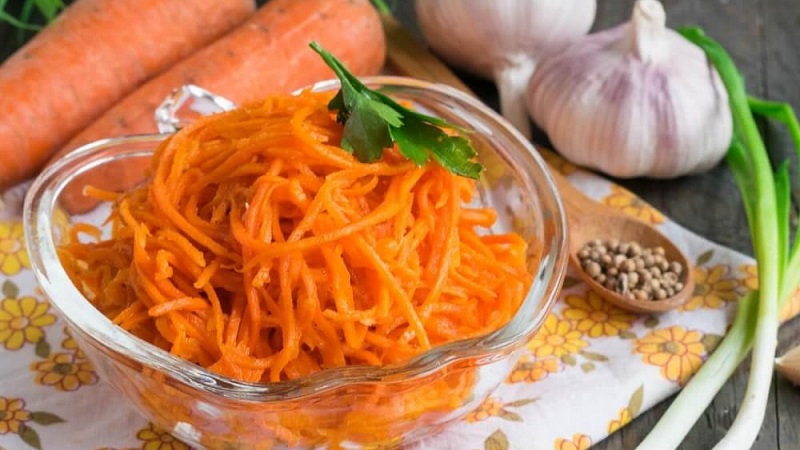
The calorie content of Korean carrots varies depending on method of preparation, the amount of vegetable oil in the snack.
The glycemic index of raw carrots is 35 units... The root vegetable is a low GI product that does not cause a sharp increase in blood sugar. However, this indicator is also unstable and depends on:
- heat treatment - the GI of boiled carrots is 85 units;
- the amount of fiber - the more, the lower it is.
The glycemic index of carrots in Korean is 63.15 units.
In addition to GI, there is a concept of the glycemic load (GL) of a product.... The calculation takes into account not only the source of carbohydrates, but also their quantity. The higher the GL, the faster the blood sugar level rises. In raw carrots, it is low and amounts to 3.5 units. Therefore, the root vegetable is allowed for use in diabetes mellitus and weight loss.
It can be useful:
Effective carrot diets and fasting days
We prepare Korean-style carrots without sterilization in jars
How much sugar is in carrots
100 g of raw carrots:
- 4.74 g sugar;
- 0.59 g glucose;
- 3.59 g sucrose;
- 0.55 g fructose.
The amount of sugar in the product is affected:
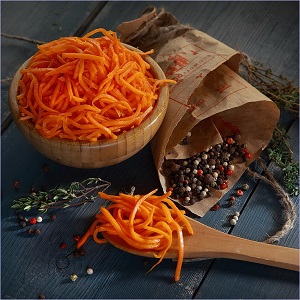 variety - root crops of different varieties differ in taste and content of sugar and carbohydrates;
variety - root crops of different varieties differ in taste and content of sugar and carbohydrates;- the degree of ripeness - in fully ripe carrots, the sugar content is higher than that of root crops of milk ripeness;
- storage conditions - fresh, juicy carrots stored in a cool dark place contain more sugar;
- growing conditions - with irregular watering, carrots release additional roots, spending sugar reserves on their growth, as a result, the root crops ripen unsweetened;
- soil type - carrots grown on acidic soil are less sweet;
- applied fertilizers - potassium, phosphorus, sodium and boron increase the sweetness of the product, and the excess of organic matter and nitrogen, on the contrary, reduces.
Is it okay to eat while losing weight or eating right
A classic Korean snack with lots of vinegar, spices, pepper, garlic and hot oil is not the best food for weight loss... Spicy, spicy, and too salty foods irritate the walls of the stomach and intestines and whet the appetite. After eating a small portion of a snack, there is a desire to eat more. As a result, the daily calorie content imperceptibly exceeds the permissible threshold.
Another thing is a diet carrot salad with the same coriander, a small amount of garlic, pepper, salt and unrefined vegetable oil... Eating such food will only be beneficial. The appetizer is safely included in the weight loss menu.
Beneficial features
The beneficial properties of a Korean snack are due to rich chemical composition of carrots:
- restorative effect on the body;
- improvement of vision;
- replenishment of vitamin deficiencies;
- strengthening the immune system;
- maintaining heart function;
- normalization of pressure;
- improvement of the digestive tract;
- reducing the risk of stroke;
- stimulation of metabolic processes;
- accelerating the breakdown of nutrients;
- prevention of oncology;
- cleansing the kidneys from small stones and sand;
- acceleration of skin regeneration;
- cleansing the blood;
- elimination of toxins;
- antibacterial action;
- removal of inflammation in the oral cavity.
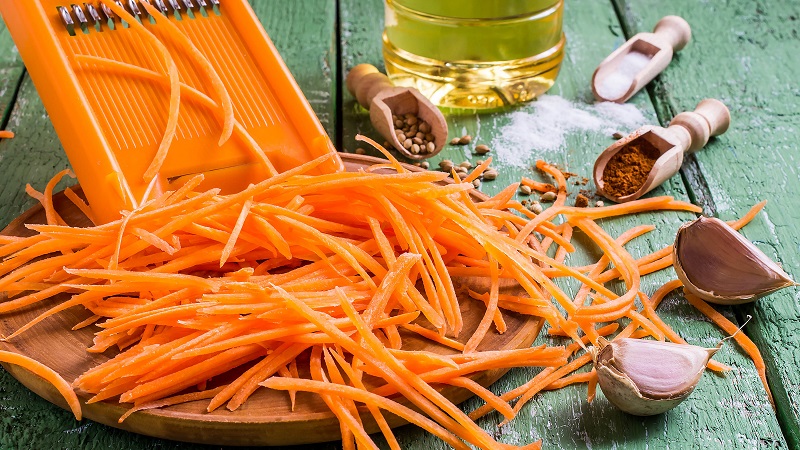
Diet recipes with Korean carrots
We suggest adopting a recipe for dietary carrots in Korean without sugar, with a small amount of vegetable oil. Combine the snack with other foods for preparing tasty and healthy dishes.
Ingredients:
- carrots - 1 kg;
- garlic - 3 cloves;
- salt - 25 g;
- Fitparad sugar substitute - 4 sachets;
- apple cider vinegar - 25 ml;
- ground coriander - 20 g;
- ground chili - 1 tsp;
- olive oil - 20 g.
KBZHU ready-made dish per 100 g:
- calorie content - 51.92;
- proteins - 1.48;
- fats - 1.93;
- carbohydrates - 7.63.
Preparation:
- Wash the carrots, peel them off with a vegetable peeler. Grind for carrots in Korean. Transfer to a deep bowl, season with salt, add pepper, coriander, sweetener.
- Stir and pour in vinegar. Leave for 20 minutes for the carrots to juice.
- Add the minced garlic and season with olive oil.
- Transfer the salad to a container with a lid and refrigerate for 5-6 hours. Shelf life is 2 weeks.
Chicken fillet salad
This dish will appeal to those who prefer hearty salads that replace a full meal. Pickled cucumber will add spice.
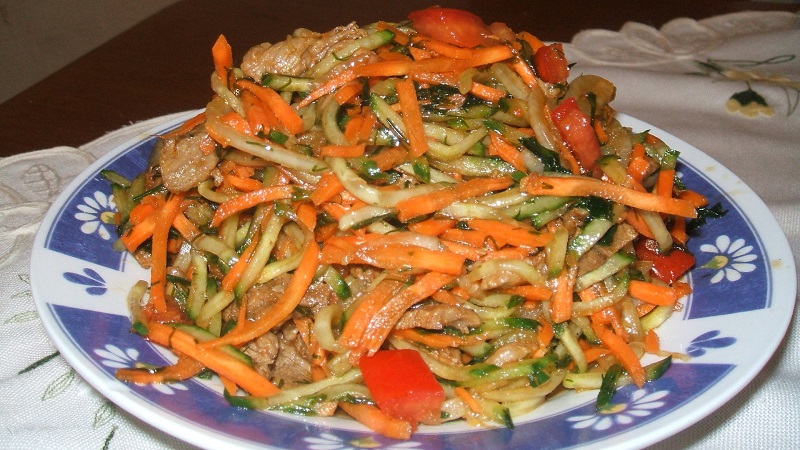
Ingredients:
- homemade Korean carrots - 300 g;
- chicken fillet - 200 g;
- hard low-fat cheese - 100 g;
- pickled cucumber - 3 pcs.;
- sour cream 10% - 2 tbsp. l .;
- parsley, dill - to taste.
Preparation:
- Boil poultry until tender, cut into cubes or strips.
- Finely chop the cucumbers into strips, chop the cheese on a grater.
- Wash and chop greens.
- In a deep container, mix the components of the salad, season with sour cream.
- Garnish with parsley when serving.
Council. Season to taste as Korean carrots are already salted.
Bean salad
This salad perfectly saturates, relieving hunger for a long time.
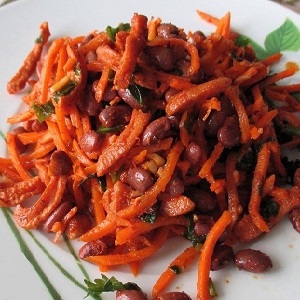 Ingredients:
Ingredients:
- chicken fillet or turkey ham - 300 g;
- Korean carrots - 200 g;
- boiled white beans - 150 g;
- green onions to taste;
- olive oil - 1 tbsp l.
Preparation: disassemble the boiled fillet into fibers (cut the ham into cubes), mix with carrots, beans, chopped onions and season with olive oil.
Apple salad
A sour crunchy apple will add a refreshing and juicy touch to this salad.
Ingredients:
- tomatoes - 3 pcs.;
- Korean carrots - 200 g;
- apple - 1 pc.;
- parsley to taste;
- olive oil - 1 tbsp l.
Preparation: Peel the apple, remove the seeds, chop into strips. Cut the tomatoes into large pieces. In a bowl, combine all the ingredients, add chopped herbs and season with vegetable oil.
Take a note:
Dried carrots, how to prepare them and where to use them
Salad with corn and raisins
This dish mixes the savory taste of Korean carrots with the sweetness of raisins.
Ingredients:
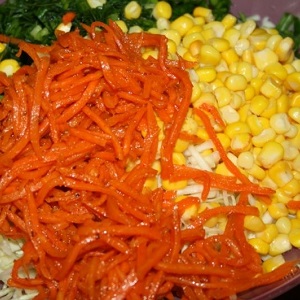 boiled chicken fillet - 300 g;
boiled chicken fillet - 300 g;- boiled corn grains - 100 g;
- Korean carrots 200 g;
- onions - 1 pc .;
- lemon juice - 2 tbsp. l .;
- raisins - 50 g;
- low fat yogurt - 100 ml.
Preparation:
- Disassemble the poultry into fibers.
- Peel the onion, cut into small cubes and pour over the lemon juice.
- Pour raisins with boiling water, leave for 10 minutes, then rinse with water.
- In a deep bowl, combine all the ingredients and season with yogurt.
With seaweed
This dish is for lovers of healthy seaweed.
Ingredients:
- seaweed - 200 g;
- Korean carrots 200 g;
- fresh cucumber - 2 pcs.;
- olive oil - 2 tablespoons l.
Preparation: Wash cucumbers and chop into oblong strips, mix cabbage, carrots, cucumbers in a deep container and season with oil.
Mussel salad
The recipe will appeal to connoisseurs of seafood and lettuce.
Ingredients:
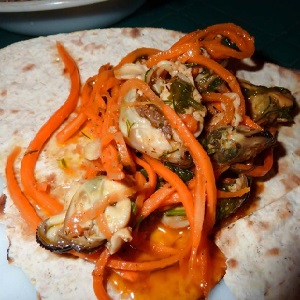 mussels - 0.5 kg;
mussels - 0.5 kg;- cherry tomatoes - 200 g;
- Korean carrots - 150 g;
- a mixture of lettuce leaves - 300 g;
- olive oil - 2 tablespoons l .;
- lemon juice - 1 tbsp l.
Preparation:
- Place lettuce leaves on a flat plate.
- Top with halved cherry and mussels.
- Form a small slide of carrots and drizzle with olive oil mixed with lemon juice.
Contraindications to use
Korean carrots it is advisable to exclude from the diet for people suffering:
- gastric ulcer and 12 duodenal ulcer, gastritis and other inflammatory processes in the gastrointestinal tract;
- root vegetable allergy;
- urolithiasis - in the presence of large kidney stones;
- liver pathologies - the product contains a large amount of beta-carotene, and the body cannot cope with the breakdown of the substance.
Conclusion
Korean-style carrots cooked according to the traditional recipe do not contribute to weight loss due to the content of hot spices that stimulate the appetite and refined oil heated to high temperatures. However, nutritionists advise not to give up your favorite snack, replacing it with a dietary option with a small amount of spices and olive oil. Such carrots contain the maximum amount of nutrients and go well with other products.